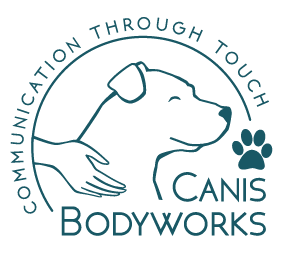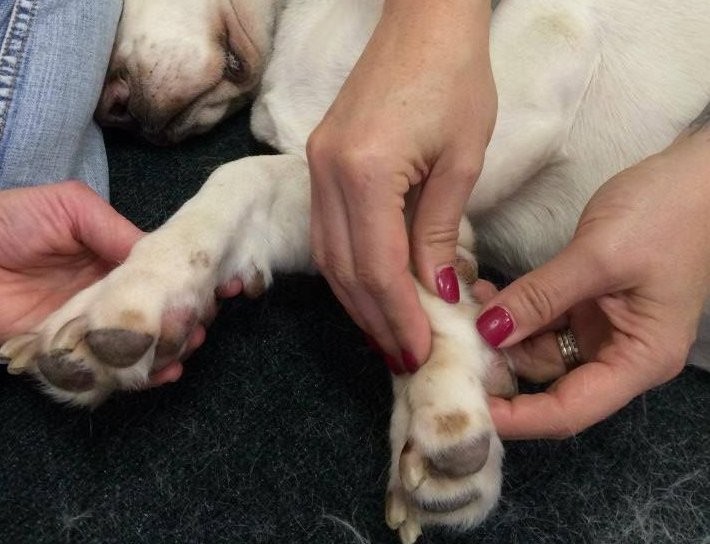One of massage’s silent (but strong) partners in canine bodywork is the ancient practice of acupressure. Acupressure is a non-invasive modality that serves as a valuable tool in our bodywork toolbox, and it comes in handy even when massage may be contraindicated.
Based in Traditional Chinese Medicine (TCM), acupressure, along with its partner acupuncture, has been a respected and scientifically proven form of prevention and treatment for thousands of years. Acupressure, unlike acupuncture, uses finger pressure rather than specialized needles to stimulate specific points (called acupoints) on the body in order to benefit physical and emotional well-being. Because acupressure doesn’t require the use of needles, anyone with a fundamental understanding of TCM concepts and acupoint locations can use this modality safely.
As canine massage therapists, we already have a variety of massage techniques we can employ in just about any situation; but we find that having an additional modality like acupressure at the ready gives us a unique edge when it comes to addressing the needs of each individual animal we encounter.
While most of us use acupressure points along with our massage techniques during treatment sessions, there are situations in which we find that acupressure takes center stage.
Here are just a few examples from our personal experiences that show how acupressure can serve as an important adjunct or substitute to massage techniques:
More examples abound, but through our work with animals of every age and ability, we have come to believe wholeheartedly that acupressure is just as vital as massage techniques. Acupressure allows us to widen and deepen our skills and our capacity to provide effective, safe therapy to all of the animals in our care.
Based in Traditional Chinese Medicine (TCM), acupressure, along with its partner acupuncture, has been a respected and scientifically proven form of prevention and treatment for thousands of years. Acupressure, unlike acupuncture, uses finger pressure rather than specialized needles to stimulate specific points (called acupoints) on the body in order to benefit physical and emotional well-being. Because acupressure doesn’t require the use of needles, anyone with a fundamental understanding of TCM concepts and acupoint locations can use this modality safely.
As canine massage therapists, we already have a variety of massage techniques we can employ in just about any situation; but we find that having an additional modality like acupressure at the ready gives us a unique edge when it comes to addressing the needs of each individual animal we encounter.
While most of us use acupressure points along with our massage techniques during treatment sessions, there are situations in which we find that acupressure takes center stage.
Here are just a few examples from our personal experiences that show how acupressure can serve as an important adjunct or substitute to massage techniques:
- Duncan is a 14-year-old Dachshund who has a chronic itchy skin condition, Cushing’s disease, and arthritis in his hips. When his itch is being well managed, his bodywork sessions include a combination of massage techniques and selected acupressure points that address his Cushing’s disease, musculoskeletal and skin issues, as well as those that benefit his immune system in general. However, when Duncan’s itchy skin has a flare up, we focus exclusively on acupressure points since massage techniques increase circulation and exacerbate his itchiness.
- Katy is an anxious 11-year-old Sheltie with an autoimmune disorder that affects her connective tissues, making them break down and compromising her joint stability. While massage techniques are beneficial for addressing her compensatory muscles, acupressure points that address not only her musculoskeletal issues but also her emotional well-being are an important part of each treatment.
- Diagnosed with a rare and inoperable form of cancer deep within her ear canal, Hufflepuff the cat was immediately placed on hospice status by her medical team. Only very superficial massage techniques were appropriate to use with Hufflepuff because she was in a fragile state. However, acupressure provided her with comfort, care, and emotional support up to the very end. (Just a side note: cats respond very well to acupressure, even when they won’t tolerate massage techniques.)
- After 7-year-old Bear, an active and healthy German Shepherd, had surgery to repair a broken bone in his fore limb, he was treated almost immediately post-surgery with gentle lymphatic drainage massage and acupressure points addressing pain and immune system support as well as those that encourage liver detoxification.
More examples abound, but through our work with animals of every age and ability, we have come to believe wholeheartedly that acupressure is just as vital as massage techniques. Acupressure allows us to widen and deepen our skills and our capacity to provide effective, safe therapy to all of the animals in our care.




